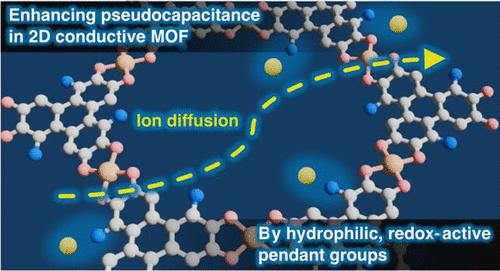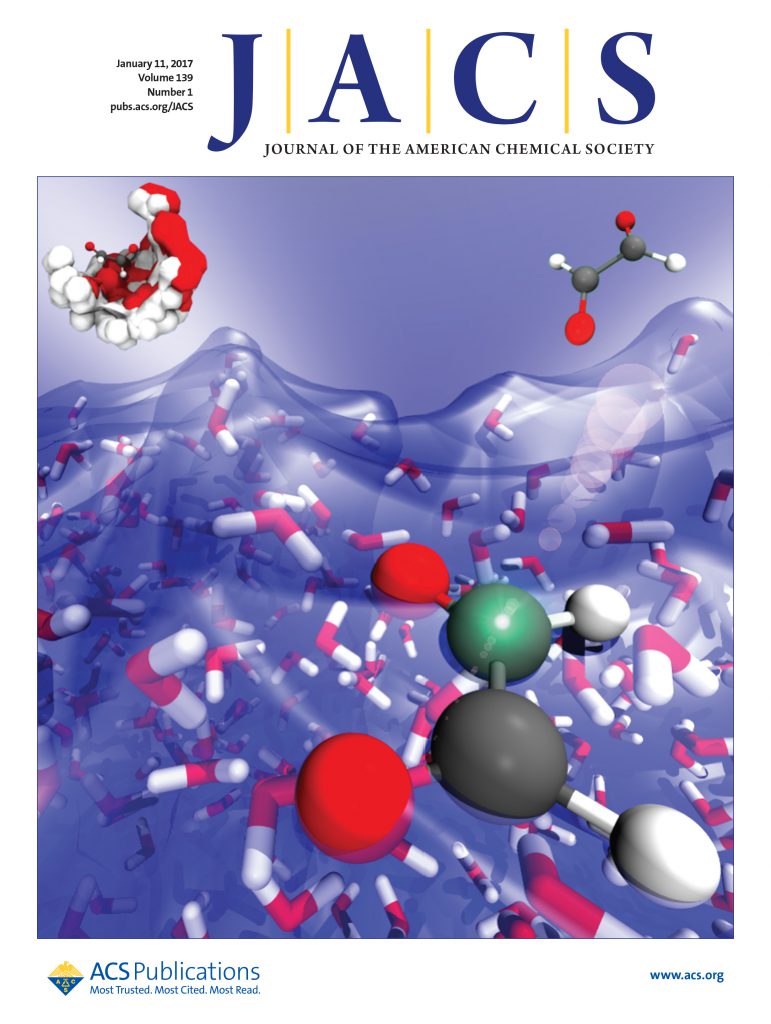在二维导电金属有机框架中进行分子级孔隙调节以实现先进的超级电容器性能
IF 14.4
1区 化学
Q1 CHEMISTRY, MULTIDISCIPLINARY
引用次数: 0
摘要
二维导电金属有机框架(MOFs)具有高导电性、高比表面积和内在氧化还原活性位点,因此已成为超级电容器活性电极材料的可行候选材料。尽管它们具有良好的电化学性能,但其通过快速、可逆的电荷转移反应产生的假电容行为仍有待充分利用。在这里,我们研究了 Cu3(HHTATP)2(HHTATP = 2,3,6,7,10,11-六羟基-1,5,9-三氨基三亚苯)的电化学储能机理。Cu3(HHTATP)2 具有伪电容性电荷存储功能,在放电速率为 0.2 A g-1 时的平均重力电容为 340 ± 15 F g-1,在 5 A g-1 的条件下进行 7000 次电静电循环后,电容保持率超过 90%。极性悬垂胺不仅通过额外的胺/亚胺氧化还原活性提高了电容,还通过改良的电极-电解质相互作用降低了界面电荷转移电阻。这些结果凸显了分子级孔隙环境调整作为储能应用材料设计战略方法的潜力。本文章由计算机程序翻译,如有差异,请以英文原文为准。

Molecular-Level Pore Tuning in 2D Conductive Metal–Organic Frameworks for Advanced Supercapacitor Performance
Two-dimensional (2D) electrically conductive metal–organic frameworks (MOFs) have emerged as viable candidates for active electrode materials in supercapacitors due to their high electrical conductivity, high specific surface area, and intrinsic redox-active sites. Despite their promising electrochemical performance, their pseudocapacitive behavior via fast and reversible charge transfer reactions remains yet to be fully exploited. Here, we investigate the electrochemical energy storage mechanism of Cu3(HHTATP)2 (HHTATP = 2,3,6,7,10,11-hexahydroxy-1,5,9-triaminotriphenylene), a 2D conductive MOF featuring characteristic redox-active pendant aromatic amines. Cu3(HHTATP)2 exhibited pseudocapacitive charge storage with an average gravimetric capacitance of 340 ± 15 F g–1 at a discharge rate of 0.2 A g–1 and maintained a capacitance retention over 90% after 7000 galvanostatic cycles at 5 A g–1. The polar pendant amines not only enhanced capacitance via additional amine/imine redox activity but also reduced interfacial charge transfer resistance through modified electrode–electrolyte interactions. These results highlight the potential of molecular-level pore environment tuning as a strategic approach in materials design for energy storage applications.
求助全文
通过发布文献求助,成功后即可免费获取论文全文。
去求助
来源期刊
CiteScore
24.40
自引率
6.00%
发文量
2398
审稿时长
1.6 months
期刊介绍:
The flagship journal of the American Chemical Society, known as the Journal of the American Chemical Society (JACS), has been a prestigious publication since its establishment in 1879. It holds a preeminent position in the field of chemistry and related interdisciplinary sciences. JACS is committed to disseminating cutting-edge research papers, covering a wide range of topics, and encompasses approximately 19,000 pages of Articles, Communications, and Perspectives annually. With a weekly publication frequency, JACS plays a vital role in advancing the field of chemistry by providing essential research.

 求助内容:
求助内容: 应助结果提醒方式:
应助结果提醒方式:


